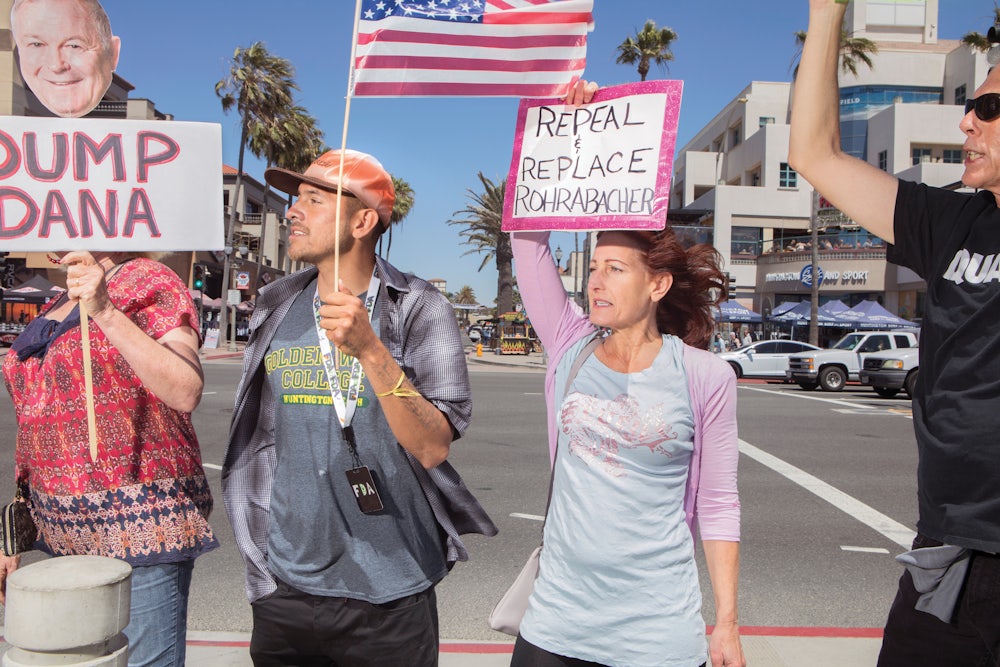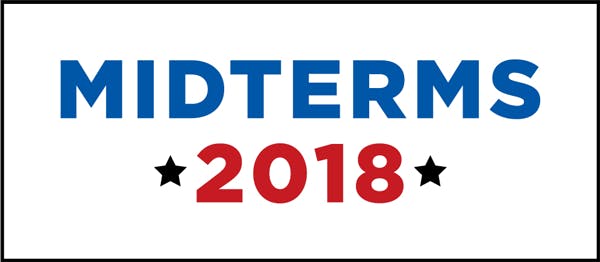What, in the age of Donald J. Trump, should a Democrat be? It didn’t take long, after Trump’s victory in the 2016 presidential election, for Democratic officials to descend into a desperate and often acrimonious argument about the future of the party. Did it still rest with white working-class voters in the Rust Belt—those factory workers and retail employees who used to form the core of the Democratic Party but have watched the American dream fall victim to globalization and automation? Would it be comprised of a diverse, urban coalition clustered around cosmopolitan, white-collar cities? And might it be possible—doubtful, perhaps, but possible—that both could be true?
With this fall’s midterm elections fast approaching, the Democratic Party has yet to resolve its internal conflicts or develop a coherent long-term vision. But it has identified a potential path back to power in the immediate term. In order to regain control of the House of Representatives, the Democratic Party must flip 23 Republican-held seats. To do so, it has identified 104 GOP-held districts as targets, the biggest number in more than a decade. It is zeroing in, especially, on Republican-held districts where Hillary Clinton defeated Trump: suburban areas near Miami, Denver, Chicago, Seattle, Dallas, and, especially, Los Angeles, where affluent, well-educated white populations have been joined in recent decades by an influx of immigrants. If Trump’s success in Rust Belt states such as Michigan and Pennsylvania symbolized the Democratic Party’s growing rift with white, working-class Americans, his poor showing in the suburbs has presented an opportunity for Democrats to make inroads in places that, for decades, have been thought of as inexorably conservative. “The battleground is not urban America or rural America, it’s suburban America,” Chicago Mayor Rahm Emanuel told Politico last year. Brian Fallon, a Democratic consultant who worked as a top Clinton aide, said that the path to a Democrat-led House “runs through the Panera Breads of America.”
The question that no one seems quite able to answer, however, is what kind of Democrat can win the Panera demographic. Last June, when Jon Ossoff failed to capture the suburban Atlanta district vacated by Republican Tom Price—in what became the most expensive House race in U.S. history—some in the party argued that Ossoff, with his lack of interest in single-payer health care and taxing the rich, had alienated potential Democratic voters by being too moderate. To win, they asserted, Democratic candidates should tack further to the left, in the mode of Bernie Sanders. In March, however, following Conor Lamb’s narrow victory in a Pennsylvania district that Trump won by nearly 20 percentage points, pundits argued that Lamb’s careful, centrist positions helped win him the race—and that Democrats shouldn’t write off more conservative Americans as a lost cause just yet.
Going forward, there is no better place to witness the Democratic Party’s strategies play out—and no place where the stakes are higher—than Orange County, California. Wedged along the Pacific coast between Los Angeles and San Diego, Orange County is home to more than three million people, living in a maze of communities ranging from surfer towns to exurbs. Orange County doesn’t offer a sense of place so much as a sense of placelessness, and if it weren’t for the consistently balmy weather, much of it, with its six-lane freeways and big-box stores and strip malls and, yes, Panera Breads, could just as soon be in Illinois or Texas. The county’s orange groves are long gone; if you are in Anaheim, say, and find yourself craving an orange, you drive to Ralphs and buy one. When, on a recent visit, I asked a lifelong resident to take me on a tour, he brought me past his childhood home in a quiet neighborhood of low-slung ranch houses, a 7-Eleven, and a large shopping center.
For decades, Orange County—the birthplace of Richard Nixon, the Crystal Cathedral, and the “Real Housewives” reality-TV franchise—was one of the country’s proudest Republican strongholds. In 2016, though, Clinton beat Trump there by a nine-point margin, becoming the first Democratic presidential candidate to win the county since Franklin D. Roosevelt’s second term.
It was a striking upset, but, to those who knew the county well, not an entirely surprising one. Republican sentiment has been eroding in Orange County for years. By 2016, fewer than 38 percent of Orange County residents were registered Republicans, down from 56 percent in 1990. Latinos and Asians now make up more than half the population, slowly replacing the white conservatives who flocked to Orange County in the middle of the twentieth century. “The generation of people who came here from the Midwest, attracted to the agriculture and defense industries, is really just dying out,” said Fred Smoller, a professor of political science at Chapman University.
Click, hold, and drag


It is here, in these suburbs, that the Democratic Party hopes to return to power nationally. Anti-Trump sentiment in Orange County runs high. The morning after Trump’s inauguration, more than 20,000 people turned out for the Women’s March in Santa Ana, one of the biggest protest marches in the entire state. And the county’s four congressional districts currently held by Republicans—Darrell Issa, Dana Rohrabacher, Mimi Walters, and Ed Royce—are among the 23 districts represented by Republicans that Clinton won nationally. The independent, nonpartisan Cook Political Report lists Royce’s and Issa’s districts as leaning Democratic (Issa won by only 1,621 votes in the last election), and Rohrabacher’s is a toss-up. While Walters’s district leans Republican, Clinton nonetheless beat Trump there by a five-point margin, putting it on the Democrats’ map. The party’s hopes soared in January when Royce announced that he would not seek reelection. Just two days later, Issa said he would be retiring as well.
Democrats have made Orange County a particular focus of their organizing and fund-raising efforts. Democratic enthusiasm has swept across Orange County, with more than a dozen candidates signing up to compete for its four Republican-held congressional seats. Last spring, the Democratic Congressional Campaign Committee made the unprecedented decision to open an office in Irvine, in the center of Orange County, to oversee races in the western states, something it had traditionally handled from its headquarters in Washington, D.C. “It’s very important to us to win Orange County for the purposes of taking back the House,” Representative Ted Lieu, a Democrat from Torrance, California, who is the vice chairman of the DCCC for the western region, told me. Tom Steyer, one of the Democratic Party’s largest donors, is pouring millions of dollars into get-out-the-vote efforts in Orange County and told me he considers the region “critical” to regaining control of Congress. According to the Democrats’ arithmetic—which assumes that the districts where Clinton won are the ripest for flipping—the four Republican-held Orange County districts should be among the 23 easiest targets in the nation. If Democrats can’t win those seats, the path to retaking Congress becomes much narrower. But their investment in Orange County represents much more than a math problem. At a time when the Democratic Party seems lacking in direction, its approach in Orange County, and whether it is successful, could provide more precise answers about the party’s future than its leaders have been willing or able to provide.
The Republican Party has tried to downplay the threat that increased Democratic engagement in Orange County signifies. “It’s a Hail Mary play. It’s desperation,” Fred Whitaker, the chairman of the Orange County Republican Party, told Politico earlier this year. “Let the Democrats spend tens of millions of dollars here. Let them die on the hill in Orange County.” Still, in response to the DCCC’s efforts, the National Republican Campaign Committee has opened its own local campaign office in Orange County. And even Whitaker has admitted that retaining control of the county’s congressional seats will be difficult. “We understand what money can do,” Whitaker told me. “Certainly, if the Democrats are going to put money here, there are going to be challenging races.”
Yet even as political headwinds seem to be blowing in their favor, the chances of a Democratic sweep of Orange County are increasingly in question. Given its internal divisions, it has been unclear from the start whether the Democratic Party can harness the energy of its grassroots while also drawing in centrists and Republicans. On top of that, a quirk of California politics—a primary system in which the top two vote-getters, regardless of their party affiliation, advance to the general election—has raised the possibility that some of the Orange County districts will end up with two Republicans, and not a single Democrat, on the congressional ballot in November. What began as a murmur of self-doubt in Orange County political circles has intensified into one of the Democratic Party’s biggest nightmares: Even with all this momentum on their side, are Democrats about to blow their chance at retaking Congress?
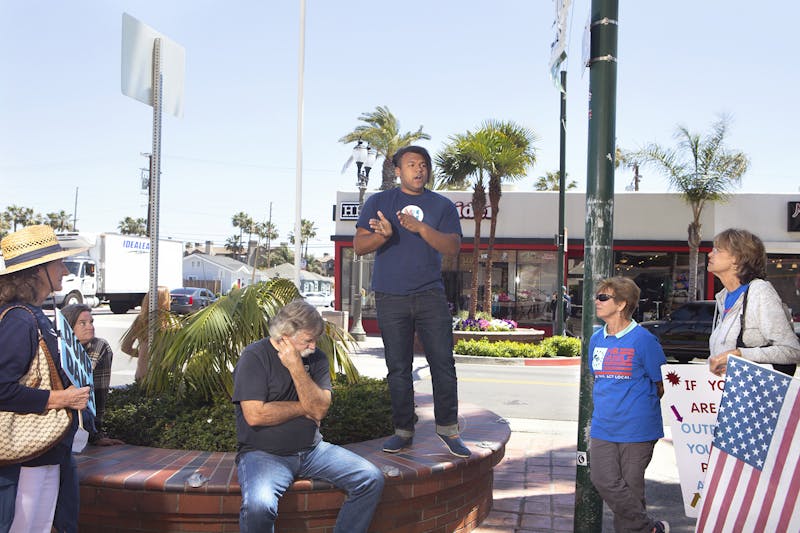
One warm afternoon last spring, on a beachfront plaza across the street from Dana Rohrabacher’s office in Huntington Beach, I watched a woman in a pink pussy hat lead more than a dozen banner-waving protesters in chants. “When Trump lies, people die!” they shouted. “This is what constituents look like!”
Since Trump’s election, grassroots groups have become increasingly active across Orange County. In Issa’s district, protesters from Indivisible 49, a local chapter of the Indivisible movement, along with other groups, staged a “die-in” outside his office, complete with tombstone-shaped posters, to highlight his fierce opposition to the Affordable Care Act. Activists in Walters’s district delivered valentines to her office: “Roses are red. Our district is blue. We demand a town hall but a new rep will do.”
Indivisible OC 48, in Rohrabacher’s district, has been among the most organized. Rohrabacher, in office since 1989, has a loyal constituency. While he stands to the right of Orange County voters on issues like gun rights and immigration, he embodies the local culture on an aesthetic level—he surfs, smokes pot, and plays the banjo—and, perhaps more importantly, has never faced a serious, well-funded opponent. In 2016, voters in his coastal district, which includes Huntington Beach and Laguna Beach, narrowly chose Clinton over Trump, but they handed Rohrabacher a victory of nearly 17 points.
The Indivisible group has been working to call attention to Rohrabacher’s Trumpian positions on global warming (“not man-made, if it is in fact even occurring”), Obamacare (“nonsensical”), and Russia (“We’ve been treating Russia as if it’s still a hostile dictatorship that wants to undermine democracy every place they can in the world, and that’s just not the case anymore”). Rohrabacher’s name has come up in special counsel Robert Mueller’s investigation of Russian interference in the presidential election. One of Trump’s former advisers, Rick Gates, pleaded guilty to charges including lying to investigators about a discussion he and Trump’s campaign chairman, Paul Manafort, had with Rohrabacher about Ukraine in 2013, the year before Russia annexed Ukraine’s Crimean Peninsula. (“The three reminisced and talked mostly about politics,” Rohrabacher’s spokesman said at the time. “The subject of Ukraine came up in passing.”) Democrats hope that by highlighting Rohrabacher’s Russia ties and other similarities with Trump, they can both energize the Democratic base and siphon off votes from Republicans who dislike the president.
In Washington, Dan Sena, the executive director of the DCCC, has been eager tap into all of the grassroots energy emerging in California. Soon after Trump’s inauguration, the DCCC announced a program called March Into ’18, an allusion to the women’s marches, in which the committee would fund state Democratic parties to hire organizers in swing districts who would, the group said, “urge local activists to become supporters of the DCCC and focus their attention on House Republicans.”
Sena opened the DCCC office in Irvine and hired a political consultant with Southern California experience named Kyle Layman to run it. “We are not going to make the mistake that an awful lot of people do in California, where you try to send in outsiders to do it, and it ends horribly,” Sena, who began his career in the state, told me.
Soon, seven more staffers joined Layman in an Irvine co-working space next to the city’s main shopping mall. With a sun-bleached, palm-lined view, kombucha on tap, and a common area shared with startup founders, the office bears little resemblance to the DCCC’s starched-shirt national headquarters. The DCCC directed funds to the California Democratic Party to hire an organizer, Katharine Marrs, who would travel around the state forming ties with local groups and persuading them to support the committee’s agenda. In Issa’s district, for example, Marrs helped create an “action council” that convenes once a month, so that leaders from grassroots groups, unions, and local Democratic clubs can work together to organize protests, canvassing events, and candidate debates and make sure their efforts don’t overlap. At the Irvine office, DCCC staffers have spent most of their hours on the more conventional task of recruiting candidates, studying the districts, and strategizing about how best to spend funds.
The dozen-plus Democratic candidates running for Congress in the county include a retired Marine colonel, a Qualcomm scion, a pediatrician, two University of California, Irvine law professors, several business executives, and, notably, not a single established politician. While most tend to avoid the rhetoric of radicalism, they are outspoken about their anti-Trump feelings and emphasize issues where the president, and, by extension, their Republican opponents, are most out of step with the Orange County mainstream: climate change, immigration, health care. In many ways, a field of anti-establishment newcomers could be seen as a potential benefit; after Clinton’s defeat, the Democratic Party is no more beloved here than the Republicans. But it also means a lot of unvetted, unproven nonpoliticians whose viability the DCCC has had a hard time assessing.
Last year, even as Democrats began declaring their candidacies, fund-raising, and making themselves visible at grassroots gatherings, Layman and his DCCC colleagues sought to add to the field, recruiting candidates with the financial resources and connections to fund their campaigns largely on their own. They reasoned that financial strength would be especially crucial this year, because the suburban districts that the Democratic Party is targeting tend to share expensive television markets with the major cities that neighbor them; advertising in Orange County, part of the Los Angeles market, is particularly expensive.
To challenge Rohrabacher, therefore, Democrats recruited a wealthy, well-connected stem-cell scientist and entrepreneur named Hans Keirstead, who had advised members of Congress on health care and biotech. Keirstead traveled to Washington last year and received the enthusiastic blessing of Democratic leaders, becoming the fifth Democrat in the race. While Democrats were courting Keirstead, a philanthropist, Democratic donor, and former Navy officer named Gil Cisneros, who lived in the same district, told party officials he might also want to run. Layman steered him instead to Ed Royce’s district, according to people familiar with their conversations. (Cisneros’s campaign manager said he always intended to run in Royce’s district, where he has family and now lives.) He is Latino, in a region with a growing Latino population, and the fact that he won a $266 million Mega Millions jackpot eight years ago also doesn’t hurt.
While national Democrats have presented themselves as working closely with the grassroots, many activists have been turned off by the DCCC’s candidate-recruitment project. “We’re just a little bit skeptical about who they might pick as their preferred candidate,” Kathleen Treseder, an Indivisible organizer, told me. “There are all sorts of national political pressures. There might be one candidate that they’re favoring because the candidate has been involved in the Democratic Party for years, but we’re just not sure that would be the candidate that we’re excited about.”
Another local Democrat, who didn’t want his name used because he didn’t want to jeopardize his relationship with party leaders, told me, “The DCCC prioritizes self-funders because it makes it easy for them, since they’re trying to compete in so many states. The problem with that is, you’re looking at how people vote for candidates solely based on the resources spent. You can spend $1 million on a marketing campaign, but if people don’t want to buy the product, that doesn’t matter. Cultural fit matters, and people want to know you can do the job.”
This wariness reflects a broader skepticism of the Democratic Party after the leak of Democratic National Committee emails, during the presidential campaign, gave the strong impression that party officials favored Hillary Clinton over Bernie Sanders during the primaries. “We were not real happy with the Democratic Party after the election,” said Andy Lewandowski, who helps run a group called Swing SoCal Left. Many in the grassroots view the DCCC’s presence in Orange County, and especially its recruitment of handpicked candidates into crowded races, as an extension of the party’s heavy-handedness during the 2016 campaign—which, they believe, ultimately cost the Democrats the election. “I think it’s a real problem,” Joanna Weiss, the founder of a political action committee called Women for American Values and Ethics, told me. “The national involvement of the DCCC in our election did not take the pulse of people on the ground.”
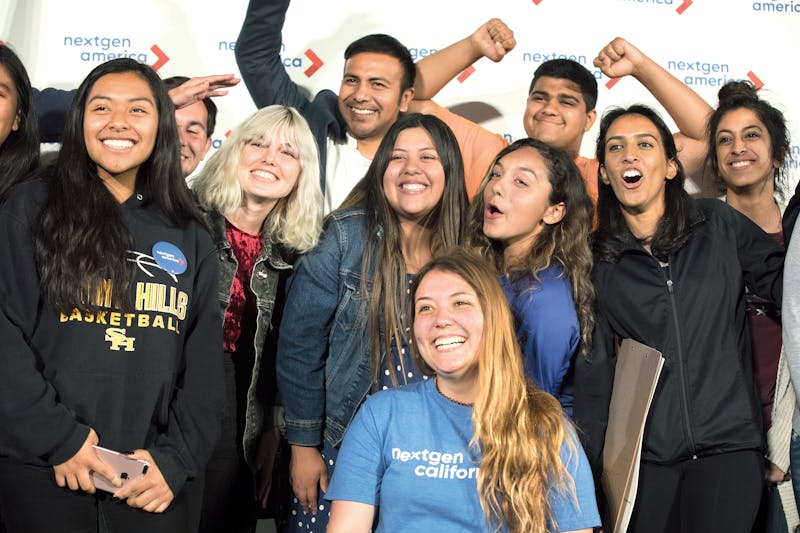
With the California Democratic primary set for June 5, these tensions between the party and the grassroots have been mounting, and the initial enthusiasm about flipping Republican districts in Orange County has given way to anxiety about what a loss would mean. On a hot, bright Saturday morning in February, about a dozen supporters of Harley Rouda, one of Rohrabacher’s most promising Democratic challengers, gathered in a parking lot near the mall in Newport Beach, holding clipboards and stacks of campaign literature. Behind a table bearing snack bars and bottled water, Rouda’s field director, a young Harvard graduate named David Kilstein, wore a sweatshirt bearing Jon Ossoff’s campaign logo; Kilstein had worked on that campaign as well. A couple of minutes after 11 a.m., Rouda appeared, wearing a crisp polo shirt and khakis. “Hey!” he called to the group. “How’s everybody doing?”
Rouda is a tall, telegenic business executive, involved in real estate and technology, who carries himself with the practiced ease of a man accustomed to making deals. He is among Rohrabacher’s most fervent critics—or, in any case, among the most retweeted—and has staked his campaign on hammering Rohrabacher for his conservative positions on health care and climate change. He gave his supporters a pep talk and apologized for not being able to join them for canvassing as planned (he had to join an Indivisible protest of offshore drilling).
Rouda caught national Democrats by surprise when he announced his campaign last March—no one had heard of him. But he has proven to be an adept retail politician, pumping hands at Indivisible rallies and gaining the respect of grassroots leaders. Currently, five Democratic candidates are still in the race—down from a total of nine—but Rouda is leading in fund-raising and, by some measures, grassroots support; he has the most Twitter followers by far—more than 35,000—and has come out ahead in unscientific polls taken at a series of Indivisible-organized candidate debates. In April, Indivisible OC 48 endorsed him.
Several weeks into the New Year, though, Rouda and the other Democratic candidates were running into trouble. The activists’ and DCCC officials’ parallel efforts to recruit Democratic candidates and hammer Republican incumbents had proven almost too successful. California is one of two states that uses a “top-two” primary system for congressional elections, in which all candidates appear on the same ballot, regardless of party, and the top two vote-getters advance to the general election.
With so many Democrats in the race, there is a serious possibility that they will split the primary vote, handing the top two ballot spots to Republicans. That would mean that in Orange County, which Democrats have identified as critical to their ability to flip the House, Democrats could be shut out of the general election entirely.
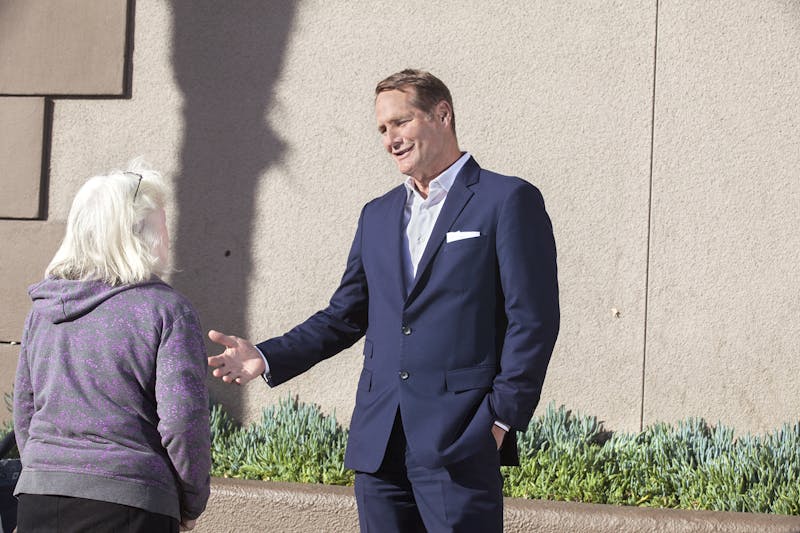
That outcome would be unusual but not unprecedented. In 2012, a congressional seat with a Democratic voter advantage, in California’s Inland Empire, went to a Republican after several Democrats split the primary vote, keeping the presumed Democratic front-runner, Pete Aguilar, from advancing. (Aguilar ran again in 2014 and won.) Democrats in Orange County worry they could well get “Aguilared,” as the phenomenon has come to be known, in the Issa and Royce districts.
In January, DCCC polling in those districts reinforced the concern, according to several people briefed on the polls. (The DCCC declined to publish its polling.) One poll in Royce’s district, in particular, showed that if all the current candidates stayed in the race, three Republicans would have more support than any single Democrat. “There is no guarantee of a Democratic representative in the election unless we narrow the field,” Mike Levin, a Democrat running in Issa’s district, told me about his own race. In March, Rohrabacher’s district was added to the list of those that could be Aguilared when the high-profile former chairman of the Orange County GOP, Scott Baugh, made a last-minute entry into the race, raising the specter of two Republicans beating all the Democrats. That leaves Walters’s district, the least vulnerable, as the only one in Orange County in which a Democrat is almost certain to advance.
These fears have threatened the fragile alliance between the Democratic Party and its grassroots leaders. Some candidates, including Keirstead, the scientist in Rohrabacher’s district, have suggested that they have the implicit support of national party officials. This has exacerbated the irritation of those in the grassroots who perceive candidates like Keirstead as crowding the race for no good reason. Some of the DCCC-recruited candidates are also viewed as being more centrist than their rivals; Keirstead, unlike Rouda, does not support free college and has been less than full-throated in his approval of single-payer health care.
The activists’ suspicions were reinforced when, in the run-up to the California Democratic Convention at the end of February, local Democratic delegates gathered for “pre-endorsement” conferences where they tallied support for candidates, to help determine who should win the coveted endorsement of the state party. At the event for Rohrabacher’s district, Keirstead emerged as the top vote-getter by a 43-point margin; Rouda came in second. In February, after winning the most support in another round of voting at the convention, Keirstead was officially named as the state party’s preferred candidate.
Fran Sdao, the chairwoman of the Democratic Party of Orange County, told me that Keirstead had simply been more skillful at lobbying delegates. But Rouda’s campaign accused the party of playing favorites; his campaign manager pointed out to reporters that Keirstead’s political director, Anita Narayana, had been the Democratic Party of Orange County’s secretary. (That said, Narayana had earlier worked for Rouda’s campaign.) In an email to supporters, Rouda’s campaign evoked the internal divisions that had roiled Democrats during the presidential election: “These endorsements are by party elites and for party elites,” the email stated. “And they shut out the voice of grassroots activists who are key to taking our country back.” Local activists have echoed the criticism. “The Democratic nomination, that’s their process,” Aaron McCall, of Indivisible OC 48, told me. “But it goes against what we’re looking for. We don’t want 30 people to decide, ‘This is the dude.’”
The DCCC, which officially has no role in the state party’s endorsement process, has tried to distance itself from this kind of conflict. “Grassroots activists have been critical to holding House Republicans accountable, and the DCCC has recognized and appreciated their success and influence in making these races competitive,” said Drew Godinich, the group’s regional press secretary, in a carefully worded statement. “Working alongside these grassroots activists and the California Democratic Party, the DCCC is keeping all options on the table to ensure that voters have a Democrat on the ballot this November.”
Still, the committee called the least viable candidates in Issa’s and Royce’s districts, sharing the frightening poll results with them and pressuring them to drop out. “For the most part, I’ve been trying to get the DCCC to stay neutral in these races, because I think the electorate should decide,” Representative Lieu, the DCCC’s western vice chair, told me. “But in these districts, there’s a math problem where we could get boxed out in November, and that’s not helpful to any of these folks.”
People familiar with the DCCC’s conversations said its tactics were subtle—Layman and others pleaded for help narrowing the field, rather than demanding that particular candidates withdraw—and somewhat ineffective; candidates questioned the DCCC’s polling, and only a few of them pulled out ahead of a March filing deadline, after which the names of any dropouts will still appear on the ballot. The local Democrat who criticized the DCCC’s work in Orange County complained that party officials had created the problem in the first place, not only by encouraging too many candidates but by actively recruiting bad ones, and that it has taken a wrongheaded approach to solving it. With all the time and resources wasted trying to push Democrats out of the race, this person said, the party could have been getting out the vote and campaigning against Republicans. (Godinich said Democrats had been doing those things as well: “We can walk and chew gum at the same time.”)
These tensions have started to spill out in other parts of the country, as well. In late February, the DCCC made a rare, aggressive move against Laura Moser, a Democratic primary candidate in Texas. Moser is a writer and activist, one of seven Democratic candidates who had been running in suburban Houston. Texas’s 7th District resembles Orange County in many ways. It has been held by the Republican Party since the 1960s, but it is also a district where Hillary Clinton won in 2016, making it a target for Democrats this year. But Moser is well to the left of the mainstream in her district, and Democratic officials questioned her ability to win in the general election this fall.
In February, the DCCC took active steps to erode Moser’s support and keep her off the general election ballot. It publicly released opposition research against Moser that highlighted negative comments she had made about Texas. “Democratic voters need to hear that Laura Moser is not going to change Washington,” the memo said. “She is a Washington insider, who begrudgingly moved to Houston to run for Congress.”
“When there’s a truly disqualified general election candidate that would eliminate our ability to flip a district blue, that’s a time when it becomes necessary to get involved in these primaries,” DCCC spokesperson Meredith Kelly told Vox. “This district is too important to let it go without trying.” The party’s campaign to undermine Moser may have backfired, however. After the DCCC’s move to muscle her out of the race, Moser enjoyed a surge in grassroots support that propelled her into a runoff election to secure a spot on the general election ballot. While the DCCC is attempting to use a lighter touch in Orange County, its influence is clearly felt—in April, it officially threw its support behind Cisneros—and, among some locals, not appreciated. “It is,” Lieu acknowledged, “a complicated party.”
Making it onto the general election ballot is not the only problem, of course. In order to win, Democrats need to persuade their supporters—who have historically not been motivated enough to vote in midterm elections—to actually go to the polls. Midterm turnout is particularly bad among 18- to 29-year-olds, averaging just 30 percent nationwide, compared with 49 percent for voters of all ages. Democrats hope that anti-Trump sentiment will help drive turnout this fall, along with policies like free college tuition and a path to citizenship for undocumented immigrants. But that’s no guarantee of victory. In Jon Ossoff’s race in Georgia, for example, the youth vote was up 6 percent compared to the previous midterms, and Ossoff still lost. One Southern California organizer told me, “A lot of the resistance groups are white, and that’s a big problem. If people of color don’t show up, we’re dead.” Steyer’s group, NextGen America, is largely focused on turning out young voters, with a particular focus on people of color. Steyer told me, “We know if they turn out in November 2018, the way they did last year in Virginia and Alabama”—where Democrats prevailed in legislative and Senate races—“we’re going to see a very different electorate.”
But in order to win in Orange County, Democrats also need to attract moderate Republicans. While the GOP has lost ground in Orange County, its disaffected former members haven’t streamed into the Democratic Party. Democrats make up just 34 percent of registered voters, a number little changed since 1990; what has changed is that 24 percent of voters are now unaffiliated with either party. That development brings up a larger, national question. Perhaps the reason Clinton did so well in places like Orange County isn’t that those areas have moved to the left, but because the Clinton wing of the party had moved to the center.
One afternoon, I met up for lunch at a Macaroni Grill with a lifelong Republican named Tami Piscotty, an administrator for the city of Westminster. She had come of age in Southern California in the 1980s and had been the first in her family to attend college. Ronald Reagan’s ideas about self-determination resonated with her. “I picked myself up—I did it,” she told me.
In 2016, Piscotty had been prepared to vote for a Republican president; she admired Ted Cruz. But then Trump became the nominee. A much-shared video clip of him imitating a disabled journalist felt personal to her, because her father was in a wheelchair, as did his comments about women. Piscotty voted for Clinton instead. Also, while she had supported Rohrabacher in past elections—“He’s kind of a Republican wacko, but you’d see him in the community, he was a surfer”—his support for Trump disqualified him in her eyes, and she voted for his Democratic opponent, a retired professor named Suzanne Savary who isn’t running this time. Since then, Piscotty has become even more disillusioned with Trump and, by extension, Rohrabacher. She is a rare Republican member of Indivisible. At this year’s Women’s March she carried an elephant-shaped sign that read: MY GOP BETRAYED ME.
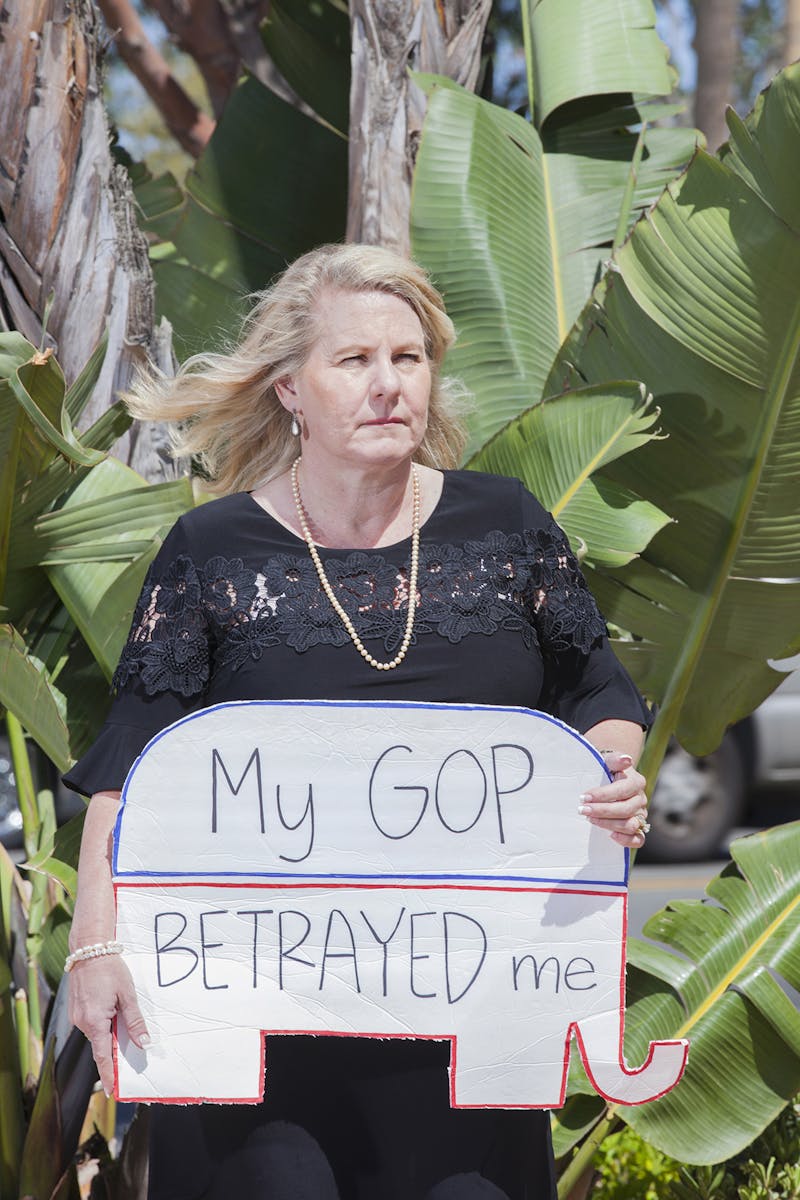
Yet looking ahead to the midterms, Piscotty hasn’t committed to voting for a Democrat; she just won’t vote for Rohrabacher. While she is pro-choice, believes climate change is real and man-made, and is concerned about the rights of minorities, she also sees Obamacare’s individual mandate as an unwanted government intrusion into private life and feels that it is unfair that undocumented immigrants use social services. Piscotty hates Trump, but that doesn’t mean she is looking for his opposite. “My concern,” Piscotty told me, “is that now that we’ve had Trump, we’re just going to turn 180 degrees and go for someone like Bernie.”
A political alliance between people like Tami Piscotty and the grassroots activists who have been leading the charge in Orange County is not a natural one, and it provokes the same internal rifts that threatened Democrats during the bruising Clinton-Sanders fight two years ago—over how much progressivism the party can, and should, bear. Democrats and Republicans alike have struggled with questions like this, of course, for about as long as the parties have existed. But in the aftermath of Trump’s victory—and Clinton’s failure both to motivate the Democratic base and attract enough unaffiliated voters to her side—it has become perhaps the most significant source of anxiety within the Democratic Party.
“It’s difficult to sit in the room when diversity of opinion is being wrangled,” said Linda May, the director of grassroots organizing for the Democratic Party of Orange County. “Republicans say, ‘OK, here are the rules, let’s walk in lockstep.’ Democrats argue.” Mark Longabaugh, a Democratic consultant who worked as a senior strategist in the Sanders campaign, told me, “One of the tricks of being good at this business is being able to walk that line.” He worries, though, that if Democrats go too far in appealing to centrists and Republicans, they could alienate their base at a crucial moment.
One evening, Piscotty invited me to a meeting of local activists hosted by Carey Jo Barnhart Chase, a member of Indivisible and HB Huddle, a Huntington Beach activist group that Piscotty had been following online, at the clubhouse of Barnhart Chase’s mobile-home park. We arrived around the same time, and Piscotty introduced herself to everyone as a Republican who no longer supports Rohrabacher. That prompted an extended riff, among the others, about the party’s ills. “Everyone talks about the Reagan era—well, that was the beginning of our fucked-up era,” said Barnhart Chase. “That’s the problem with Republicans. They’ll bend you over and fuck you with a smile.”
Piscotty blanched. “Is this the way you’re going to pick up Republican seats?” she asked the group. “We need to make this party what we want it to be,” Barnhart Chase replied. “I’m not willing to compromise what I believe in order to win.”
Later, Piscotty told me, “The Republicans in this district are like me—they’re like, ‘What the heck?’ with Donald Trump. But those Democrats are so passionate that they’re going to turn off middle-of-the-road people like me.”
Harley Rouda, the surprise upstart candidate, believes he has a winning plan to unite Orange County’s various factions. In February, I met Rouda for drinks in Laguna Beach. I had asked him to suggest a spot with some significance for him, like a neighborhood bar; he told me to meet him at Skyloft, an upscale smokehouse with $33 ribs and a view of the ocean. A couple of nights earlier, Rouda had gone to see the comedian Damon Wayans Jr. perform at Skyloft but hadn’t been impressed. The humor, he said, was too “blue-collar.”
Orange County is home to an unusual number of rich Democratic candidates who were once Republicans. And unlike in some other districts, where well-to-do businessmen might dress down to meet reporters at a barbecue pit, Orange County’s candidates tend to be unapologetic about their roots. Rouda grew up in Ohio, where his father founded a real-estate brokerage that he would eventually take over. He was raised in a Republican household, and Rouda himself voted for Republicans until the George W. Bush administration convinced him to drop his party affiliation and start choosing Democrats for president. (He says that his wife, a novelist who is a lifelong Democrat, also helped.) Still, he counts Ohio Governor John Kasich, a Republican, as a friend, and he donated to Kasich’s 2016 presidential campaign. He registered as a Democrat only last year.
Rouda is open about his conservative past, in part because he believes his profile will serve him well in the general election, when any candidate will have to appeal to non-Democrats. But one reason he has attracted admirers in the liberal grassroots is that when it comes to issues, he is positioning himself as staunchly to the left: Along with supporting Medicare for All, he believes that public universities should be free and that there should be a federal minimum wage of at least $15 an hour, which would go up in places with a higher-than-average cost of living.
Positions like this have become somewhat common among Democratic congressional candidates in Orange County, perhaps because of all the competition among them. Republicans see this as working to their advantage. “There are seats where they have eight people running, which is driving the field to the left and making them take positions that are going to be tough to defend going into the general,” Matt Gorman, the communications director for the National Republican Campaign Committee, told me. Ahead of the general election, Gorman said, national Republicans will be sure to publicize Democrats’ most leftward positions with aggressive ad blitzes.
Democrats have encouraged some candidates to keep to the center to avoid getting hammered later on: Earlier this year, The Intercept and HuffPost published leaked memos recommending that candidates use cautious rhetoric on health care and gun control. But Rouda, along with several other Orange County candidates, is testing a different tactic: advocating for social policies that will appeal to the left, while trying, in a departure from the Sanders mold, to make the case to unaffiliated voters that those policies are in fact fiscally responsible. A Medicare for All system would lower health care costs by concentrating the government’s bargaining power. Free college would make the United States more economically competitive by turning out more graduates and expanding the middle class. Rouda told me that he hasn’t polled on his positions; he took them because he believes in them and is prepared to defend them. “I am who I am,” he said.
Few of the Democratic officials or consultants I interviewed brought up this gambit—pursuing policies that energize the Democratic base, while making a case for their economic soundness to persuade suburban fiscal conservatives. But several told me that, if successful, it might well accomplish what might seem to be impossible—pull more moderates into the Democratic Party while becoming more, not less, populist. “People think in a left-right frame: ‘Oh, in a moderate district you have to be moderate,’ ” Ben Tulchin, Sanders’s pollster, who has also polled for Rouda and others in Orange County, told me. “I’m like, ‘No, you can be populist if you do it authentically and address the concerns a voter has.’ ”
That this approach is at odds with some of the Democratic Party’s advice is not at all incidental. While in years past, the party’s approval—and the endorsements and funding that followed from it—was seen as crucial to winning elections, the fact that the party is historically unpopular means that its support has become something of an albatross. After Ossoff’s loss in Georgia, DCCC officials concluded that their aggressive spending in Georgia—$5 million in total—might well have cost Ossoff the race, by allowing Republicans to tie him to much-hated national Democrats like House Minority Leader Nancy Pelosi. Months later, in Pennsylvania, the DCCC didn’t publicize the fact that it spent $1 million on Conor Lamb’s campaign until the eve of the election; after Lamb won, the DCCC put out a press release crediting its “mostly behind the scenes” involvement.
It is an awkward truth that even the DCCC sees itself as a liability for Democratic candidates. And it explains why Rouda—who, by all accounts, has quite a good relationship with the DCCC—has been positioning himself as an independent-minded antagonist to national Democrats. “At the end of the day, we trust our candidates, who have grown up in these districts and who know these communities, to take policy positions that reflect these communities,” said the DCCC’s Drew Godinich. If party officials haven’t answered all the questions that have been hurled at them since the 2016 election about how Democrats can succeed, maybe that’s because they’re not the ones with the answers.
One evening, I invited Piscotty to join me for the first of four debates that the Indivisible group in Rohrabacher’s district had organized, at a community college auditorium in Costa Mesa. This one would focus on women’s issues, and Joanna Weiss, of Women for American Values and Ethics, would moderate. I wanted to see how Rouda and others would characterize their positions and how a conservative like Piscotty would respond.
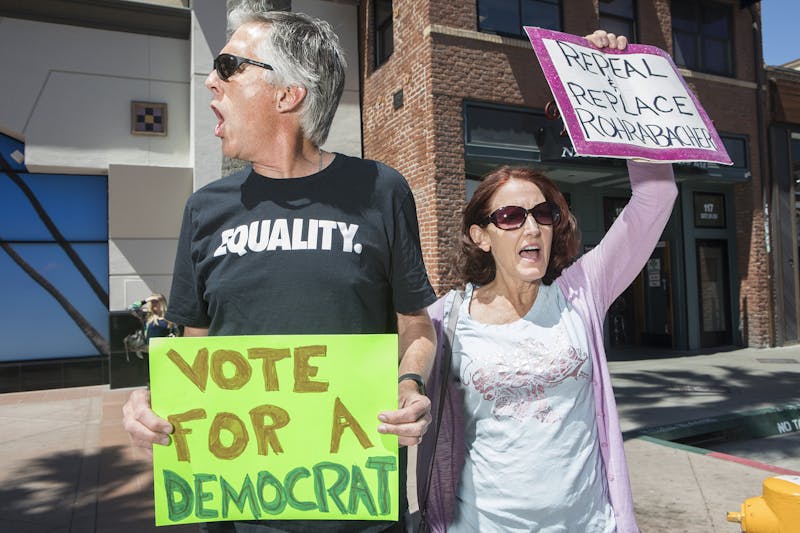
Outside, about a dozen tables had been set up by candidates and nonprofits. One of the candidates, a tech executive named Rachel Payne (who has since dropped out of the race), had put out a cheese plate; Rouda offered Twizzlers; Planned Parenthood had stickers. In years past, debates among Democratic congressional candidates had been unheard of—there hadn’t been enough of them running. But in the past year, debates and forums have become commonplace across all four of the targeted Orange County districts. And public engagement has been high. For this debate, around 800 people had shown up to watch.
I sat down with Piscotty near the back of the auditorium, and the candidates—the six deemed most viable, on the basis of local fund-raising and the cash they had on hand—filed onstage. Weiss had told me she hoped to see the candidates differentiate themselves, but it soon became clear that wouldn’t happen. She asked the candidates how they felt about a single-payer health care system, in which the government covered health care costs. “I am for Medicare for All, ” Rouda responded. “I am very much for a single-payer system,” Keirstead said. Everyone considered themselves feminists. Everyone believed minors should be allowed to have abortions without parental permission. Everyone found Trump outrageous.
Piscotty agreed with much of what she heard—though she blushed a little at a mention of gender-neutral bathrooms (“Ugh!”) and seemed perplexed by a question about prisoners’ rights. (“They have no rights—they broke the law!”) She tapped at her phone, reading up on the candidates. She followed Rachel Payne on Twitter and read an article about Keirstead. She visited the Federal Elections Commission web site to see how much money each candidate had raised.
But even after researching the candidates and hearing from them directly, she was still unsure about what she would do come Election Day. After the debate had ended, and the candidates had left the stage, she turned to me in exasperation. “Do you see any difference between them?” Piscotty asked. “How are people going to decide?”
